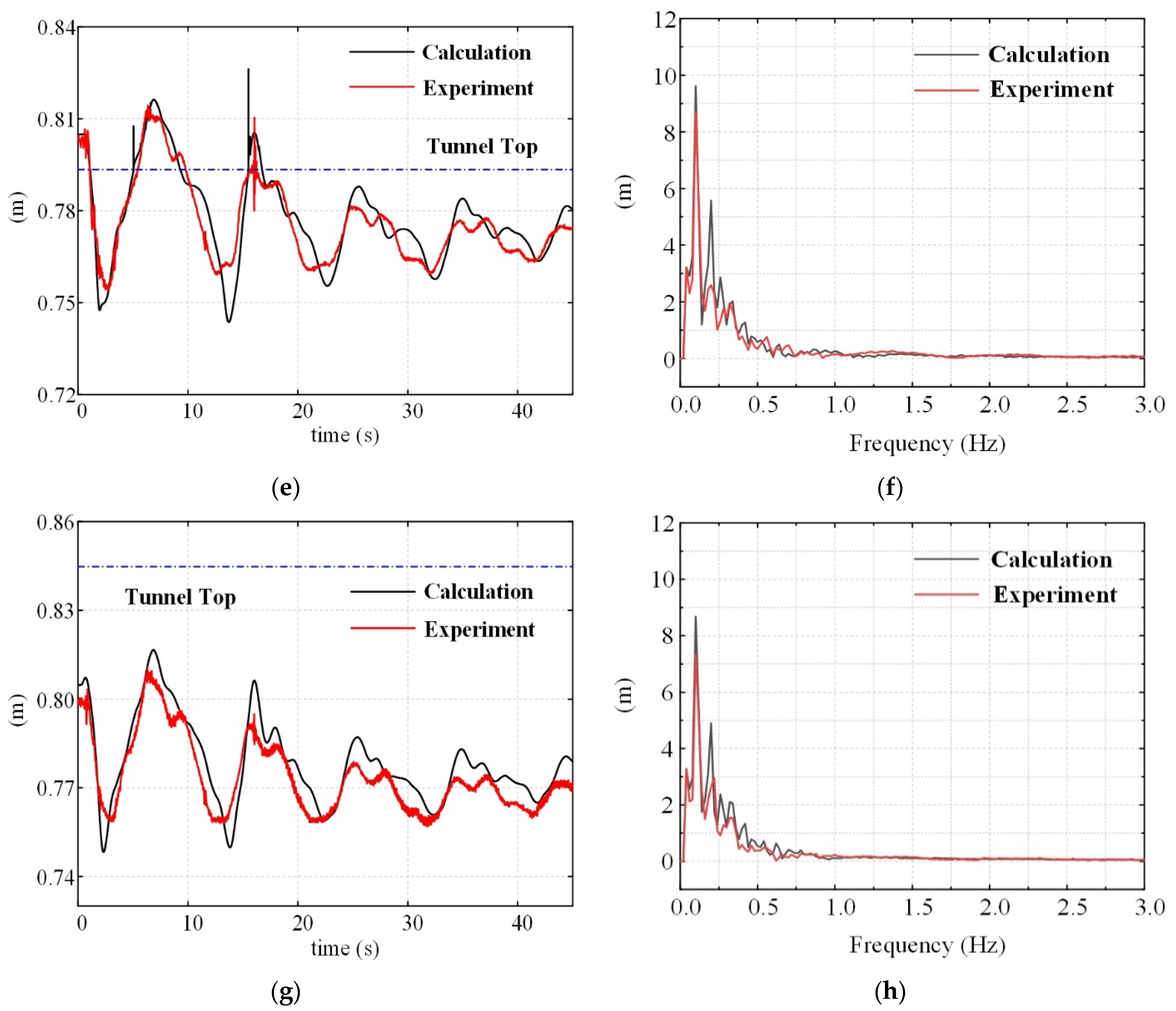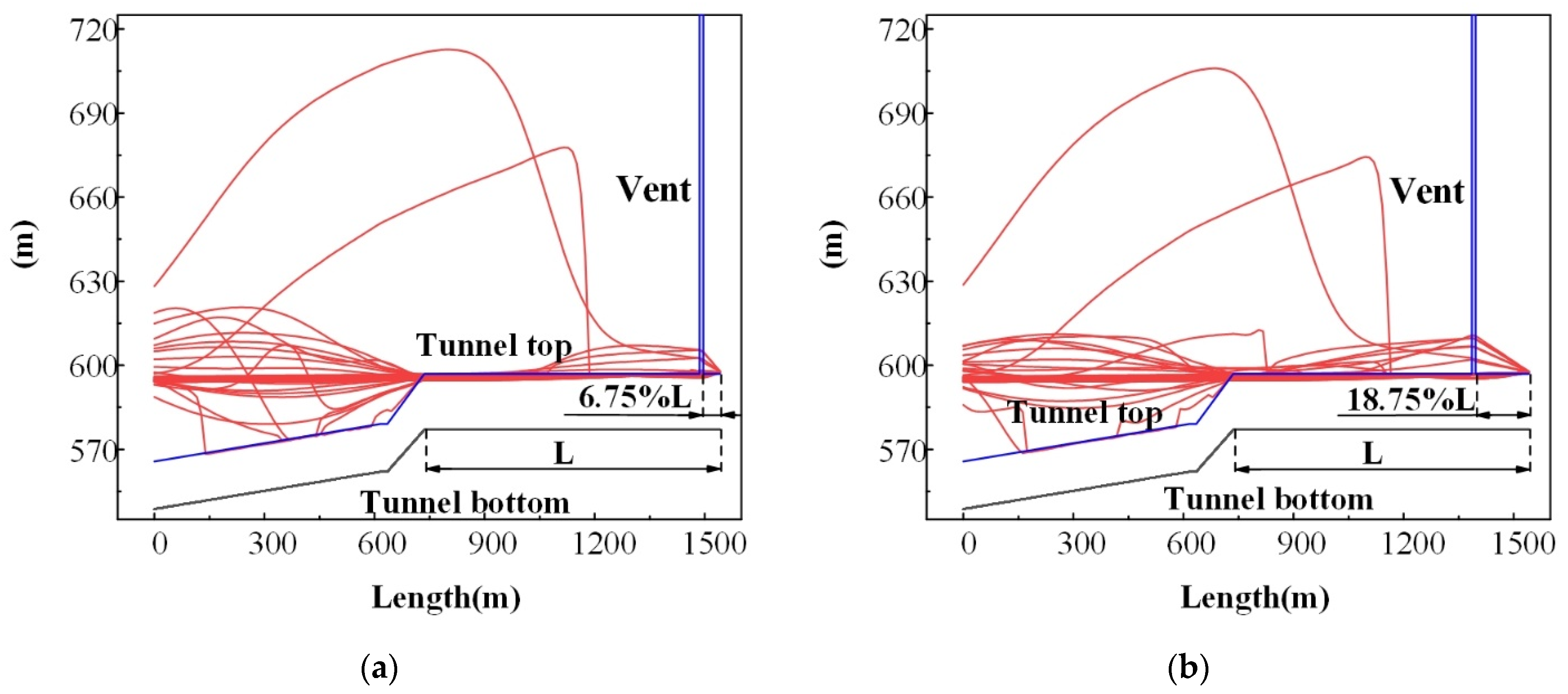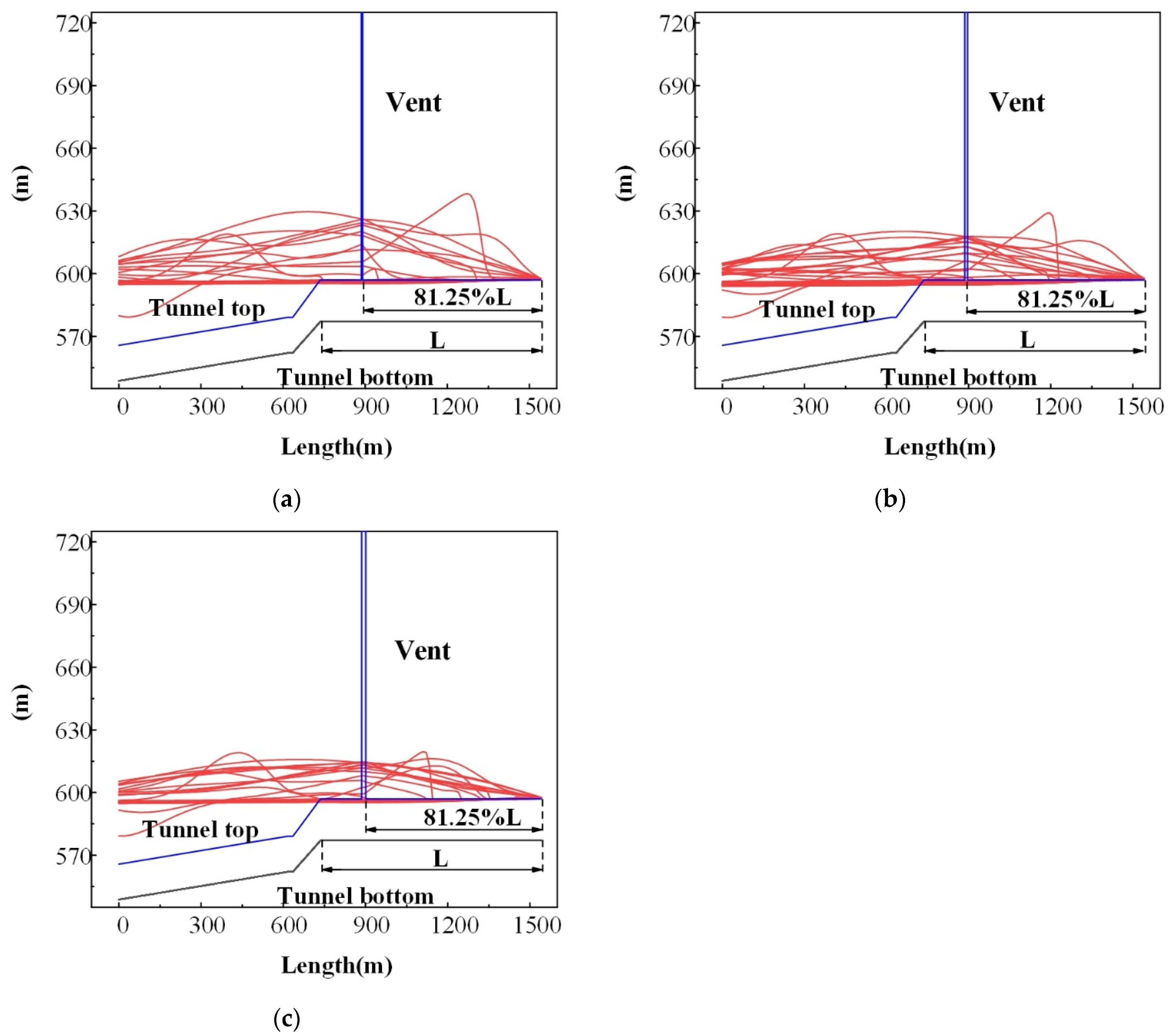Optimization Control on the Mixed Free-Surface-Pressurized Flow in a Hydropower Station
Abstract
1. Introduction
2. Research Object and Mathematical Model
2.1. Research Object
2.2. Mathematical Model
2.3. Characteristic Implicit Method
2.4. Experimental Validation
3. Analysis of Influencing Factors for the Mixed Free-Surface-Pressurized Flow
3.1. Influence of the Tunnel Relative Roughness
3.2. Influence of Vent Position
3.3. Influence of the Vent Diameter
3.4. Influence of the Vent Number
4. Conclusions
- Based on the upwind differencing and implicit finite difference scheme, the characteristic implicit method can detect and simulate the mixed free-surface-pressurized flow, which has good calculation stability. The experiment agreed well with the calculated results and validated the accuracy of the characteristic implicit method;
- The relative roughness of the tailrace tunnel influences the maximum pressure in the tailrace tunnel, and the maximum pressure decreases with the increase of the tunnel’s relative roughness when the mixed free-surface-pressurized flow occurs;
- Setting vent holes in the flat-topped tunnel section can restrain the maximum pressure caused by the mixed free-surface-pressurized flow in the tunnel, and a vent hole at 81.25%L can reduce the maximum pressure by 56.72%;
- When the diameter of the vent hole is in the range of 5~15 m, the maximum pressure in the tunnel decreases with the increase of the ventilation hole diameter;
- By increasing the number of ventilation holes in the flat-topped tunnel section, the maximum pressure in the tunnel can be reduced when the mixed free-surface-pressurized flow occurs. An optimal set of two ventilation holes at 93.75%L and 56.25%L was proposed, which could reduce the maximum pressure by 15.30%. Meanwhile, when considering the suppression effect and tunnel safety, an optimal hole diameter of 10 m is recommended.
Author Contributions
Funding
Acknowledgments
Conflicts of Interest
References
- Zhang, D.; Wang, J.; Lin, Y.; Si, Y.; Huang, C.; Yang, J.; Huang, B.; Li, W. Present situation and future prospect of renewable energy in China. Renew. Sustain. Energy Rev. 2017, 76, 865–871. [Google Scholar] [CrossRef]
- Zhang, N.; Lior, N.; Jin, H. The energy situation and its sustainable development strategy in China. Energy 2011, 36, 3639–3649. [Google Scholar] [CrossRef]
- Liu, W.; Lund, H.; Mathiesen, B.V.; Zhang, X. Potential of renewable energy systems in China. Appl. Energy 2011, 88, 518–525. [Google Scholar] [CrossRef]
- Chai, Q.; Zhang, X. Technologies and policies for the transition to a sustainable energy system in China. Energy 2010, 35, 3995–4002. [Google Scholar] [CrossRef]
- Mathiesen, B.V.; Lund, H.; Karlsson, K. 100% renewable energy systems, climate mitigation and economic growth. Appl. Energy 2011, 88, 488–501. [Google Scholar] [CrossRef]
- Huang, H.; Yan, Z. Present situation and future prospect of hydropower in China. Renew. Sustain. Energy Rev. 2009, 13, 1652–1656. [Google Scholar] [CrossRef]
- Chang, X.; Liu, X.; Zhou, W. Hydropower in China at present and its further development. Energy 2010, 35, 4400–4406. [Google Scholar] [CrossRef]
- Lu, Y.-m. The exploitation and sustainable development of hydropower in China. Water Resour. Hydropower Eng. 2004, 36, 1–4. [Google Scholar]
- Kong, Y.; Wang, J.; Kong, Z.; Song, F.; Liu, Z.; Wei, C. Small hydropower in China: The survey and sustainable future. Renew. Sustain. Energy Rev. 2015, 48, 425–433. [Google Scholar] [CrossRef]
- Liu, J.; Zhao, D.; Gerbens-Leenes, P.W.; Guan, D. China’s rising hydropower demand challenges water sector. Sci. Rep. 2015, 5, 11446. [Google Scholar] [CrossRef]
- Chaudhry, M.H. Applied Hydraulic Transients, 3rd ed.; Springer: Berlin, Germany, 2014. [Google Scholar]
- De Almeida, A.B.; Koelle, E. Fluid Transients in Pipe Networks; Computational Mechanics Publications: Southampton, UK; Elsevier Applied Science: London, UK, 1992. [Google Scholar]
- Ji, Z. General hydrodynamic model for sewer/channel network systems. J. Hydraul. Eng. 1998, 124, 307–315. [Google Scholar] [CrossRef]
- Guo, Q.; Song, C.C. Surging in urban storm drainage systems. J. Hydraul. Eng. 1990, 116, 1523–1537. [Google Scholar] [CrossRef]
- Miyashiro, H.; Yoda, H. An Analysis of Hydraulic Transients in Tunnels with Concurrent Open-Channel and Pressurized Flow; ASME, Fluids Engineering Division: New York, NY, USA, 1983. [Google Scholar]
- Li, J.; McCorquodale, A. Modeling mixed flow in storm sewers. J. Hydraul. Eng. 1999, 125, 1170–1180. [Google Scholar] [CrossRef]
- Priessmann, A.; Cunge, J.A. Calcul des intumeseences sur machines electronique. In Proceedings of the 9th Congress of International Association for Hydraulic Research, Belgrade, Yugoslavia, 3–7 September 1961. [Google Scholar]
- Chaudhry, M.H.; Kao, K.H. Shrum Generating Station: Tailrace Surges and Operating Guidelines During High Tailwater Levels; British Columbia Hydro and Power Authority: Vancouver, BC, Canada, 1976. [Google Scholar]
- Trajkovic, B.; Ivetic, M.; Calomino, F.; D’Ippolito, A. Investigation of transition from free surface to pressurized flow in a circular pipe. Water Sci. Technol. 1999, 39, 105–112. [Google Scholar] [CrossRef]
- Ferreri, G.B.; Freni, G.; Tomaselli, P. Ability of Preissmann slot scheme to simulate smooth pressurisation transient in sewers. Water Sci. Technol. 2010, 62, 1848–1858. [Google Scholar] [CrossRef]
- Maranzoni, A.; Dazzi, S.; Aureli, F.; Mignosa, P. Extension and application of the Preissmann slot model to 2D transient mixed flows. Adv. Water Resour. 2015, 82, 70–82. [Google Scholar] [CrossRef]
- Guo, Q.; Song, C.C. Dropshaft hydrodynamics under transient conditions. J. Hydraul. Eng. 1991, 117, 1042–1055. [Google Scholar] [CrossRef]
- Wiggert, D.C. Transient flow in free-surface, pressurized systems. J. Hydraul. Div. 1972, 98, 11–27. [Google Scholar] [CrossRef]
- Song, C.C.; Cardie, J.A.; Leung, K.S. Transient mixed-flow models for storm sewers. J. Hydraul. Eng. 1983, 109, 1487–1504. [Google Scholar] [CrossRef]
- Hamam, M.A.; McCorquodale, J.A. Transient conditions in the transition from gravity to surcharged sewer flow. Can. J. Civ. Eng. 1982, 9, 189–196. [Google Scholar] [CrossRef]
- McCorquodale, J.A.; Hamam, M.A. Modeling surcharged flow in sewers. In Proceedings of the International Symposium on Urban Hydrology, Hydraulics and Sediment Control, University of Kentucky, Lexington, KY, USA, 25–28 July 1983. [Google Scholar]
- Afshar, M.H.; Rohani, M. Water hammer simulation by implicit method of characteristic. Int. J. Press. Vessel. Pip. 2008, 85, 851–859. [Google Scholar] [CrossRef]
- Chunge, J.A. Numerical integration of Barre de Saint-Venant’s flow equations by means of an implicit scheme of finite differences. La Houille Blanche 1964, 1, 33–39. [Google Scholar]
- Liu, M.; Li, G.; Guala, M.; Sun, D. Experimental research on hydraulics of flood discharge tunnel and improving schemes for choking. La Houille Blanche 2017, 1, 24–32. [Google Scholar] [CrossRef][Green Version]
- Aydin, I.; Altan-Sakarya, A.B.; Sisman, C. Discharge formula for rectangular sharp-crested weirs. Flow Meas. Instrum. 2011, 22, 144–151. [Google Scholar] [CrossRef]









| Tunnel Number | Tunnel Shape Number | Length (m) | Roughness | Starting Elevation (m) | Ending Elevation (m) |
|---|---|---|---|---|---|
| (1) | 1 | 614.73 | 0.014 | 548.70 | 562.00 |
| (2) | 2 | 20.00 | 0.014 | 562.00 | 562.00 |
| (3) | 3 | 101.12 | 0.014 | 562.00 | 577.00 |
| (4) | 4 | 805.25 | 0.014 | 577.00 | 577.00 |
| Tunnel Shape Number | Description of the Tunnel Shape |
|---|---|
| 1 | Arch-like. The bottom width changes linearly from 18 m to 15 m, the tunnel height changes linearly from 21 m to 25 m, and the radius of the circular arc at the top of the tunnel changes linearly from 9 m to 7.5 m. |
| 2 | Arch-like. The bottom width is 16 m, the tunnel height is 17 m, and the tunnel top arc radius is 10.5 m. |
| 3 | Arch-like. The bottom width changes linearly from 16 m to 18 m, the tunnel height changes linearly from 17 m to 20 m, and the radius of the circular arc at the top of the tunnel changes linearly from 10.5 m to 11.25 m. |
| 4 | Arch-like. The bottom width is 18 m, the tunnel height is 20 m, and the circular radius of the top of the tunnel is 11.25 m. |
| Tunnel Relative Roughness | Maximum Pressure (mH2O) |
|---|---|
| 0.010 | 155.904 |
| 0.012 | 154.322 |
| 0.014 | 152.785 |
| 0.016 | 151.185 |
| 0.018 | 149.146 |
| Items | Number of Vents | Vent Positions | Maximum Pressure (mH2O) |
|---|---|---|---|
| Case 1 | 2 | 93.75%L 43.75%L | 62.517 |
| Case 2 | 2 | 93.75%L 56.25%L | 56.006 |
| Case 3 | 2 | 93.75%L 68.75%L | 56.345 |
| Case 4 | 2 | 93.75%L 81.25%L | 61.087 |
| Case 5 | 3 | 93.75%L 68.75%L 43.75%L | 55.398 |
Publisher’s Note: MDPI stays neutral with regard to jurisdictional claims in published maps and institutional affiliations. |
© 2021 by the authors. Licensee MDPI, Basel, Switzerland. This article is an open access article distributed under the terms and conditions of the Creative Commons Attribution (CC BY) license (http://creativecommons.org/licenses/by/4.0/).
Share and Cite
Wang, X.; Fan, H.; Liu, B. Optimization Control on the Mixed Free-Surface-Pressurized Flow in a Hydropower Station. Processes 2021, 9, 320. https://doi.org/10.3390/pr9020320
Wang X, Fan H, Liu B. Optimization Control on the Mixed Free-Surface-Pressurized Flow in a Hydropower Station. Processes. 2021; 9(2):320. https://doi.org/10.3390/pr9020320
Chicago/Turabian StyleWang, Xinlong, Honggang Fan, and Bing Liu. 2021. "Optimization Control on the Mixed Free-Surface-Pressurized Flow in a Hydropower Station" Processes 9, no. 2: 320. https://doi.org/10.3390/pr9020320
APA StyleWang, X., Fan, H., & Liu, B. (2021). Optimization Control on the Mixed Free-Surface-Pressurized Flow in a Hydropower Station. Processes, 9(2), 320. https://doi.org/10.3390/pr9020320






